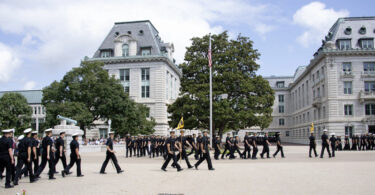By Capt. Brent Ramsey, US Navy ret
STARRS Board of Advisors
In recent years, there have been incidents, accidents, and sideshows that reflect poorly on the Navy. Problems cannot be solved and corrected without honest retrospection.
—In 2021, the USS Bonhomme Richard, a $3 billion capital ship, burned to a smoking hulk lashed to the pier. Navy personnel proved incapable of fighting the fire, and the ship was a total loss and stricken from the records. The JAG manual investigation that followed implicated poor leadership, and dozens of senior officers were disciplined as a result. An essential warship was lost to the Marines because a fundamental part of being a sailor — fighting a fire on a ship — was neglected up and down the chain of command.
—Recent surveys of Surface Navy officers show most do not aspire to command. Has command at sea become so difficult that career officers want no part of it? Why do over half of this generation of career officers fear command?
—Two entire ship classes, the Littoral Combat Ship (LCS) and Zumwalt-class destroyers, are utter failures, and another class, the Ford-class carrier, is beset with major problems in operational effectiveness years after commissioning. The LCS proved to be so ineffective that the Navy is retiring the entire class decades early, which is a spectacular waste of billions. The Zumwalt-class destroyers are likewise an embarrassment with almost zero capability after the Navy spent billions. The Zumwalt class has been reduced to being multibillion-dollar test ships. The Ford finally deployed years late but still has multiple deficiencies that have not been corrected. Ford-class carriers cost billions more than planned and took years longer to build.
—The Navy has missed its recruiting goals by thousands for two years, even with lowered admission standards. The Navy is failing to make the case to most young people that serving in the Navy is a worthy endeavor. A major source of recruiting is white males, those from the South, and Christians. These traditional sources have dried up due to the politicization of the Navy with its emphasis on diversity, equity, and inclusion (DEI) and climate change.
—The Navy just announced ships are deploying with thousands of vacancies in manning, contrary to long-standing Navy policy. Ships without adequate manning are more dangerous to operate and place undue burdens on the crews.
—During the pandemic, more than 10 times as many sailors committed suicide yearly than were lost to COVID. The Navy had a massive vaccination effort for a low-risk disease for the healthy military cohort, devoting resources to ensure every sailor was vaccinated. But it was business as usual regarding the mental health of at-risk sailors. How many lives would have been saved if the Navy had devoted the same resources used for vaccination to saving at-risk sailors?
—In 2021, the USS Connecticut collided at high speed with an unobserved underwater sea mount. Fortunately, no one died. The CO, XO, and Chief of the Boat were fired. Who else in the chain of command was culpable for certifying those in charge? The Navy suffered a long-term loss of a vital attack submarine, and only these three leaders were held accountable. The sub will not return to service until 2027, and the cost of the repairs is estimated to be $80 million. That $80 million and a five-year loss of an essential ship will harm the Navy’s readiness at a time when we can least afford it.
—Eight USS Ticonderoga-class cruisers were selected for upgrades in 2015. According to the Navy, some $2.4 billion was spent by 2021. Four of the selected ships, after being worked on for years, were quietly retired because they were too hard to fix, wasting millions. In 2024, the Navy is still working on upgrades to the remaining four cruisers with no end in sight. Has this kind of decision-making become commonplace and without consequences?
—Navy shipbuilding is under duress. The shipbuilder of the Constellation-class frigate announced the first ship would be a year late. The second Ford-class carrier (USS Kennedy) will now be commissioned in 2025, three years later than planned. Still, it will not be operational before 2027. In 2027, the USS Nimitz, the ship Kennedy is replacing, will be 52 years old. Both SSN shipbuilders have announced delays in the construction of new attack submarines. China builds warships much faster and at a much lower cost. If reforms are not implemented urgently to fix the ailing shipbuilding industry, China will soon have the world’s most powerful and capable Navy.
I served at senior levels both as a Naval officer and as a Navy civilian. I have a vested interest in the Navy. The Navy is not prospering, and if our Navy fails, the nation is at severe risk.
For our nation and our allies to be safe, a strong, competent Navy is essential — especially at a time when threats are multiplying around the world. Anything less will lead to disasters and ongoing conflicts.
More dangerous scenarios loom on the horizon. Citizens must be aware of the dangers that we face internationally.
Urge members of Congress to legislate the strengthening of our Navy and major increases in its funding. Our future as a nation depends on it.








Leave a Comment